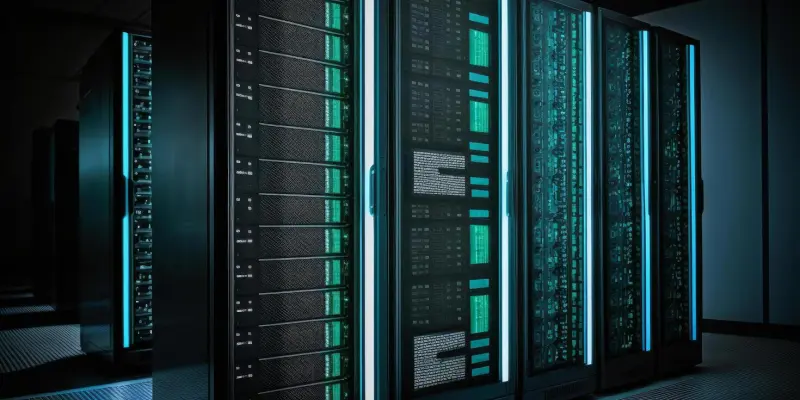Emerging technologies are reshaping industries, with Artificial Intelligence (AI) becoming a cornerstone. However, behind AI’s promise lies a pressing environmental dilemma stemming from the burgeoning infrastructure required to support its capabilities. AI data centers, essential for processing vast amounts of information, present mounting concerns related to water security across the United States. Concentrated heavily in five states—California, Arizona, Texas, Illinois, and Virginia—these centers account for a disproportionate 72% of new developments. Regions like California, already grappling with chronic drought conditions, find themselves at greater risk. The centers rely heavily on water-intensive cooling systems to prevent overheating, consuming massive volumes each day. A snapshot of this consumption shows a 100-megawatt facility using about two million liters daily, translating into billions globally. This surge places stress on existing water resources, which are vital for other sectors, such as agriculture. As water scarcity grows more severe, communities and states must confront the repercussions while urging corporations to adopt sustainable practices that harmonize technological progress with environmental responsibility.
Water-Intensive Cooling Processes and Their Impact
The cooling methods employed by AI data centers predominantly rely on water, with evaporative cooling being a widely used technique. This process poses challenges as it consistently depletes valuable local water supplies, creating tension between the tech industry and nearby communities dependent on the same resources. In many cases, the water consumed by these centers could otherwise sustain essential agricultural needs or household uses. This situation sparks broader debates on the prioritization of resources, especially in states like California and Arizona, where water is a precious commodity. The resulting strain not only threatens community livelihoods but also raises ethical questions about resource allocation as technological needs surge forward unimpeded. However, the industry is witnessing a noteworthy shift as community pushback becomes more pronounced. Companies are increasingly aware of the need for transparency and responsiveness. Instances like the backlash faced by data center operators in Chile illustrate the global nature of this challenge, compelling the sector to rethink resource-intensive practices and align with the broader sustainability agenda. As the dialogue surrounding water use and tech infrastructure sustainability evolves, some industry leaders are initiating promising changes. Prominent tech giants like Google and Microsoft have started integrating innovative cooling techniques that promise to mitigate water usage. These innovations, such as cold plates and immersion cooling, aim to reduce dependence on traditional water-reliant methods, cutting consumption by as much as 52%. This signifies a significant step forward in addressing both immediate and long-term environmental concerns. At the same time, initiatives like rainwater harvesting and geothermal cooling are gaining traction, introducing alternative solutions that reduce the ecological footprint of AI operations. These advancements underscore the growing acknowledgment within the industry of its responsibility to minimize water usage and adopt renewable methods that safeguard essential resources. As new cooling technologies evolve, their adoption could redefine the balance between technological expansion and ecological preservation, shaping a future where AI development aligns more closely with sustainable practices.
Community Pushback and Industry Responses
Community responses have begun to sway the narrative for industrial giants, urging them to reconsider the environmental implications of their operations. In regions where data centers contribute to water stress, local resistance has become formidable. Protests and campaigns amplify the voices of those affected, calling for greater accountability and urging data centers to take a proactive stance in resource management. These communal engagements have prompted leading corporations to adapt, as witnessed in the collaborative efforts in areas like Chile. Data center operators are being pushed to acknowledge their practices’ broader societal impacts, prompting a reevaluation of priorities. Stakeholder engagement is emerging as a key theme, encouraging companies to alter strategies that foster alignment with community expectations and environmental commitments. This shift is catalyzing changes not by regulatory pressures alone, but also through the power of public sentiment and local advocacy that are now undeniable drivers of corporate policy reform. In response to mounting pressure, industry leaders are implementing a range of strategies to manage their water footprints responsibly. Water stewardship programs exemplify corporate acknowledgments of the environmental challenges posed by their facilities. These initiatives aim to foster sustainable practices, improving water efficiency and ensuring responsible consumptive patterns. Furthermore, data centers are turning toward renewable energy sources and advanced technologies to reduce ecological impacts. Hyperscaler companies are increasingly deploying closed-loop systems and adaptive innovations that minimize water wastage. While these initiatives reflect progress, the journey toward sustainability is ongoing. As expectations for sustainable practices rise, corporations face the imperative of developing robust systems that not only balance operational demands but also exemplify a commitment to ethical resource management. The challenge lies in seamlessly integrating these endeavors within a growth-driven industry, paving the way for enhanced sustainability in tech infrastructure across both its existing footprint and future developments.
Sustainable Solutions and Future Directions
Emerging technologies are transforming industries, with Artificial Intelligence (AI) as a central component. Yet, AI’s potential brings an environmental challenge due to the expansive infrastructure it requires. AI data centers are crucial for handling massive data but raise increasing concerns about water security in the United States. Heavily concentrated in five states—California, Arizona, Texas, Illinois, and Virginia—these centers represent a significant 72% of new projects. California, plagued by chronic droughts, faces heightened risks. These centers use water-intensive cooling systems to prevent overheating, consuming enormous volumes daily. A 100-megawatt facility can use about two million liters daily, leading to billions of liters globally. This spike strains current water resources, which are crucial for areas such as agriculture. As water scarcity worsens, communities and states must tackle these challenges, encouraging companies to embrace sustainable practices that align technological progress with environmental stewardship.

